Bsp
Every time I see an 1inch xps fr I do wonder if this is a good material to use,I have used 5mm xps and 10 k and above is readily available also how the exciter is atached to the panel is very important.
As for impulse response ,large panels will always take longer to stop vibrating .
Must go.
Steve
Every time I see an 1inch xps fr I do wonder if this is a good material to use,I have used 5mm xps and 10 k and above is readily available also how the exciter is atached to the panel is very important.
As for impulse response ,large panels will always take longer to stop vibrating .
Must go.
Steve
As I was saying,a 2ft piston speaker would have a longer tail than a 4inch unit.
Dml works differently you have the first pulse from the coil (tectonic call this the primary drive I think)which gives you the fast rise time and short delay, but then after that the Dml takes over ,this is all pretty well explained on the tectonic videos.
But I'm not sure a single pulse test signal would help a lot as all you would be looking at is the reflection of pulse from the panel edge and back again, which is what you would expect from any type of large panel,without these reflections Dml wouldn't work.
What is desired for piston type units is not desired for Dml ,this is where people used to measuring cone type units come unstuck, they are like chalk and cheese, hopefully you'll only get them mixed up once.
Steve
Dml works differently you have the first pulse from the coil (tectonic call this the primary drive I think)which gives you the fast rise time and short delay, but then after that the Dml takes over ,this is all pretty well explained on the tectonic videos.
But I'm not sure a single pulse test signal would help a lot as all you would be looking at is the reflection of pulse from the panel edge and back again, which is what you would expect from any type of large panel,without these reflections Dml wouldn't work.
What is desired for piston type units is not desired for Dml ,this is where people used to measuring cone type units come unstuck, they are like chalk and cheese, hopefully you'll only get them mixed up once.
Steve
Spedge,
Agree with you that 1inch XPS is not ideal. But what is what is readily available. Have not yet found a source of thinner XPS material. I am in California.
The ECT and impuse response were not from a pulse test. They were generated from frequency sweep data by REW software.
I also tried out couple of other boards
Foam Board - 20" x 30" x 3/16" (yellow color)
Thick Foam Board - 20" x 30" x 7/16" (White color)
The thinner 3/16 board had best ETC graph among the boards. From that metric it should be better than XPS. I have attached the SPL and ETC graphs. The SPL has 1/48 smoothing, the ETC has 0.3ms smoothing.
How does the foam board sound compared to XPS? Looking for other peoples experiences.
Agree with you that 1inch XPS is not ideal. But what is what is readily available. Have not yet found a source of thinner XPS material. I am in California.
The ECT and impuse response were not from a pulse test. They were generated from frequency sweep data by REW software.
I also tried out couple of other boards
Foam Board - 20" x 30" x 3/16" (yellow color)
Thick Foam Board - 20" x 30" x 7/16" (White color)
The thinner 3/16 board had best ETC graph among the boards. From that metric it should be better than XPS. I have attached the SPL and ETC graphs. The SPL has 1/48 smoothing, the ETC has 0.3ms smoothing.
How does the foam board sound compared to XPS? Looking for other peoples experiences.
How does the foam board sound compared to XPS? Looking for other peoples experiences.
bsp,
I assume that by "foam board" you mean what I call "foam core". that is, polystyrene foam with paper skins sold at stores like Michael's for science fair displays and the like, correct? If so, my own observations are that it it suffers from pretty much the same issues as XPS (and EPS) foam. That is, that it starts losing output somewhere between 2 and 5 kHz, and, that is sounds muddy, or mushy, or hollow, depending on how you choose to describe it.
Before you give up on the DML concept, try some 1/4" plywood. Look especially for underlayment plywood like Patriot Plywood's Sureply or Revply. This plywood is really inexpensive (same or cheaper than than the pink foam), and equally available, at least on the east coast. For sure, you will be disappointed by how much less SPL you get. But some of us have found that it provides flatter response to 10 kHz or higher, and without the hollow sound. Try it for yourself and see whet you think. It's too inexpensive NOT to try.
Eric
Veleric,
Yes by foam board I do mean foam core". that is, polystyrene foam with paper skins sold at stores like Michael's for science fair displays.
Next up I will try plywood.
Looks like the image attachments did not come through in my last post. Trying again.
Yes by foam board I do mean foam core". that is, polystyrene foam with paper skins sold at stores like Michael's for science fair displays.
Next up I will try plywood.
Looks like the image attachments did not come through in my last post. Trying again.
Attachments
Veleric.
I agree with you about foam core ,it is heavily damped by the paper .
Eps on on the other hand has no problem reaching 10k (1inch 70 grade) or 20k and beyond with the vh grade.
When I have time I will take some pics of FR and post fore you to see,but that won't be until the end of the week probably.
If anyone can't wait, you can look in audiocircle on dml for pro use and look in my gallery to see my now pretty old pics of eps responses.
Bsp.
The 5mm xps I used was an under laminate floor damping material, ill sort out which and post some pics or this one too ,as you can tell I have rather a lot of different panel materials lying around.
Steve
I agree with you about foam core ,it is heavily damped by the paper .
Eps on on the other hand has no problem reaching 10k (1inch 70 grade) or 20k and beyond with the vh grade.
When I have time I will take some pics of FR and post fore you to see,but that won't be until the end of the week probably.
If anyone can't wait, you can look in audiocircle on dml for pro use and look in my gallery to see my now pretty old pics of eps responses.
Bsp.
The 5mm xps I used was an under laminate floor damping material, ill sort out which and post some pics or this one too ,as you can tell I have rather a lot of different panel materials lying around.
Steve
Today I almost finished my tall and thin panels I just have to mount the exciter and spline with 2 part epoxy glue.
For those that didn't know you need to use some type of adhesive when mounting the spline to the exciter the same way you need adhesive to mount the exciter to the panel diaphragm. As yawl know my adhesive of choice is 2 part epoxy glue. Epoxy and Wood glue both dry pretty hard but have some dampening properties. I use 2 part 5min. epoxy because it dries way faster then wood glue.
I hope Burntcoil was right about tall and thin panels having more bass. If not I will just make another pair but instead of 12inches it will be 20inches width.
One thing good about Coronavirus is that it gives me more free time to do my DML projects. lol
For those that didn't know you need to use some type of adhesive when mounting the spline to the exciter the same way you need adhesive to mount the exciter to the panel diaphragm. As yawl know my adhesive of choice is 2 part epoxy glue. Epoxy and Wood glue both dry pretty hard but have some dampening properties. I use 2 part 5min. epoxy because it dries way faster then wood glue.
I hope Burntcoil was right about tall and thin panels having more bass. If not I will just make another pair but instead of 12inches it will be 20inches width.
One thing good about Coronavirus is that it gives me more free time to do my DML projects. lol
Hi Guys!
After seeing the T.I. video about a year ago I always wanted to build a pair of DMLs. So I was reading through all DML threads across different forums and now I'm here.
I started with 2 pairs so that I could compare them against each other:
- 1200x600x4mm poplar ply wood
- 1250x600x20mm XPS 300
As it was my first try I started with Dayton Audio DAEX25FHE-4 exciters. I sanded the XPS, rounded the corners and applied the 1:1 PVA glue / water mix (2 layers). The ply wood only got rounded corners, otherwise it was untreated. For exciter placement I've chosen the 2/5, 3/5 rule.
For my first listening test I've put them on pillows and leaned them towards another set of pillows on my tower speakers. So they were damped a bit and should not rattle.
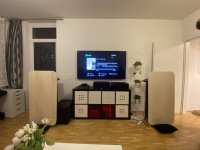
First I tried the XPS. I hooked everything up, turned on the music and then........I was very disappointed. There was no lower end (as expected) but also no lower midrange (everything to about 200Hz seemed to be thin). Middle range seemed to be super dominant and highs were sharp.
So I tried the PLY and it was a bit better, but still having all the same issues just not that severe - but far far away from good HIFI sound.
After that I used my UMIK-1 and took some measurements. Unfortunately they are on my other PC where I don't have access to right now. But the measurements just showed what I've heard. So I EQed them first by ear and then using REW and it got better. But again, they were not even close to my small rear speakers, the Dali Zensor 1.
At this point I didn't want to give up and tried different speaker placements like hanging them from strings.
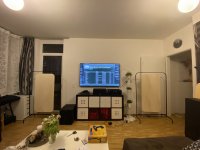
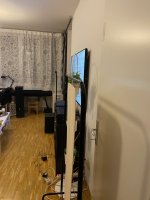
The XPS got worse but the plywood did a better job. As they were not anyhow damped they played quite a bit louder as well.
At this point I really wanted to try a different exciter with more punch, because I hoped to get a better low-end. So I ordered 4 more Dayton Audio DAEX32EP-4 Thrusters. As I read many many times that XPS works that well for many people I wanted to give it another try but using the proportions from the Dayton Audio exciter guide which says that the width should be 4/5 of the height. For the plywood I used the same dimensions but different wood. So the new pairs were:
- 1200x600x4mm beech ply wood
- 750x600x20mm XPS 300
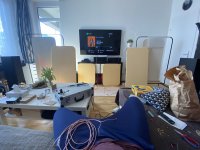
The Thruster immediately had a better bottom end and I thought it was going into the right direction.
At this point I thought about supporting the panels, as it's something many people suggest. So I build frames with a spline and tried multiple different mounting methods of the panels to the frame. I built one frame for the small XPS panel and one for the plywood panels.
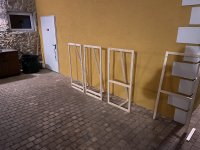
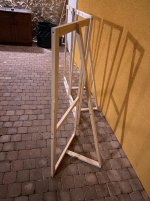
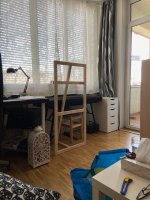
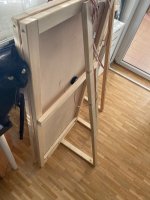
I tried 1mm, 3mm and 6mm double sided foam tape for the panels. I also tried to mount the small panel in a "free" way so it was held only by ducktape and foam within the frame. Unfortunately I didn't take any pictures of this experiment. The splines and exciters are/were attached either by double sided foam tape or hot glue.
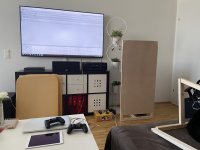
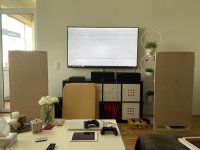
Again, I was EQing them which helped a lot. I realized that I over damped the small XPS panel and it sounded weird. Softer and thicker foam adhesives were much better. But still, I preferred the sound of the ply panel. The difference between the beech and poplar is, that the beech is much heavier and harder, therefore I used the stronger Thruster exciter. On the softer poplar I have the smaller 25FHE-4.
So I removed the small XPS panel from the frame and mounted the poplar ply. But this time differently, top and bottom were not attached to the frame, only the 2 long sides. In general, I tried to use small strips so that it is not over-damped.
I also played them in series, so that I could have 4 panels playing at the same time. In that case I have 2x 1200x600 for the left and right channel. I'm also playing them together with a 12" sub, crossed at either 80 or 100Hz.
I was listening to it now for about 1 week and now I switched back to my main speakers for a comparison. I also have to say that I don't have really high end speakers. It's just a pair of Dali Zensor 7. I flattened them using REW to have a fair comparison. I turned them on and.....WOW. What a full and detailed sound. It may be my room and the speaker placement but I do get a big soundstage where the speakers "disappear", very good highs but then again, full lower midrange as well.
So I'm not sure if my expectations were too high or if I'm still doing something completely wrong but I just have to say that my cone speakers do sound simply much better.
After seeing the T.I. video about a year ago I always wanted to build a pair of DMLs. So I was reading through all DML threads across different forums and now I'm here.
I started with 2 pairs so that I could compare them against each other:
- 1200x600x4mm poplar ply wood
- 1250x600x20mm XPS 300
As it was my first try I started with Dayton Audio DAEX25FHE-4 exciters. I sanded the XPS, rounded the corners and applied the 1:1 PVA glue / water mix (2 layers). The ply wood only got rounded corners, otherwise it was untreated. For exciter placement I've chosen the 2/5, 3/5 rule.
For my first listening test I've put them on pillows and leaned them towards another set of pillows on my tower speakers. So they were damped a bit and should not rattle.

First I tried the XPS. I hooked everything up, turned on the music and then........I was very disappointed. There was no lower end (as expected) but also no lower midrange (everything to about 200Hz seemed to be thin). Middle range seemed to be super dominant and highs were sharp.
So I tried the PLY and it was a bit better, but still having all the same issues just not that severe - but far far away from good HIFI sound.
After that I used my UMIK-1 and took some measurements. Unfortunately they are on my other PC where I don't have access to right now. But the measurements just showed what I've heard. So I EQed them first by ear and then using REW and it got better. But again, they were not even close to my small rear speakers, the Dali Zensor 1.
At this point I didn't want to give up and tried different speaker placements like hanging them from strings.


The XPS got worse but the plywood did a better job. As they were not anyhow damped they played quite a bit louder as well.
At this point I really wanted to try a different exciter with more punch, because I hoped to get a better low-end. So I ordered 4 more Dayton Audio DAEX32EP-4 Thrusters. As I read many many times that XPS works that well for many people I wanted to give it another try but using the proportions from the Dayton Audio exciter guide which says that the width should be 4/5 of the height. For the plywood I used the same dimensions but different wood. So the new pairs were:
- 1200x600x4mm beech ply wood
- 750x600x20mm XPS 300

The Thruster immediately had a better bottom end and I thought it was going into the right direction.
At this point I thought about supporting the panels, as it's something many people suggest. So I build frames with a spline and tried multiple different mounting methods of the panels to the frame. I built one frame for the small XPS panel and one for the plywood panels.




I tried 1mm, 3mm and 6mm double sided foam tape for the panels. I also tried to mount the small panel in a "free" way so it was held only by ducktape and foam within the frame. Unfortunately I didn't take any pictures of this experiment. The splines and exciters are/were attached either by double sided foam tape or hot glue.


Again, I was EQing them which helped a lot. I realized that I over damped the small XPS panel and it sounded weird. Softer and thicker foam adhesives were much better. But still, I preferred the sound of the ply panel. The difference between the beech and poplar is, that the beech is much heavier and harder, therefore I used the stronger Thruster exciter. On the softer poplar I have the smaller 25FHE-4.
So I removed the small XPS panel from the frame and mounted the poplar ply. But this time differently, top and bottom were not attached to the frame, only the 2 long sides. In general, I tried to use small strips so that it is not over-damped.
I also played them in series, so that I could have 4 panels playing at the same time. In that case I have 2x 1200x600 for the left and right channel. I'm also playing them together with a 12" sub, crossed at either 80 or 100Hz.
I was listening to it now for about 1 week and now I switched back to my main speakers for a comparison. I also have to say that I don't have really high end speakers. It's just a pair of Dali Zensor 7. I flattened them using REW to have a fair comparison. I turned them on and.....WOW. What a full and detailed sound. It may be my room and the speaker placement but I do get a big soundstage where the speakers "disappear", very good highs but then again, full lower midrange as well.
So I'm not sure if my expectations were too high or if I'm still doing something completely wrong but I just have to say that my cone speakers do sound simply much better.
Bonjour
Morning all, I hope you are all well.
So I paid a visit to the house in France for the annual maintenance visit and France has closed its borders. for the foreseeable future I am stuck in France.
So I have too much time on my hands and nothing but theory to play with.
Looking back at the measurements I got from the Tall Blonde DML’s I threw together I think there is still potential for taking this further. There is still a lot to explore and understand. For example Veleric’s test result suggest to me it might be strongly material related, as the profiles he used gave different results to the ones I got. Spedge’s results were more in line with what I found but with a different material. I am begining to think that material stiffness is significant in influencing the performance I got. Veleric’s material is twice the thickness of the ply I am using on the Tall Blondes. And then you have the width to length ratio also influencing the panel stiffness. I cut the tall panels down from a spare sheet of the laserboad ply I used for the large Ealing panels and the large panels, which are twice the width of the Tall panels, are definitely stiffer. This isn’t a surprise as there is twice the material resisting bending.
Yes I am still clutching a straws at this point.
Until I can get at more ply I am left with speculating what I might be able to do with the thin profile which some of you might find interesting. Its all theory, so if you aren’t interested thanks for reading so far.
Here is what I am thinking
The averaged FR response for the tall Blonde panels is included below for reference. The second image is the FR response for my reference B&W CM1’s in the same room which I found interesting. Its obvious to see how the CM1’s response was tailored
As you can see I get quite a smooth response until I hit 125Hz to 250Hz where the is a circa 6db suck-out.
The suck-out can be equalised out, I have tried it successfully, to give me a nice response down to 31Hz. The caveat is that with one exciter per panel I can’t get high SPL’s, the exciter excursion is far too great reaching its 3mm max at modest volume.
So to give me eq headroom I am going to build a four panel array, with one exciter on each panel, and see if for the material I use I can get the SPL I want at 30Hz.
"Thats OK if you have the space" you might say and thats a fair challenge, although I would argue you could use an array like this in a smaller room if you are happy with wall hanging which I have done with success in Ealing.
However, there are other options to consider. As DML’s are mostly bipolar in action you don’t have to worry about cancelation. This opens up a lot of options like overlapping panels to some degree or arranging panels like floor standing screens. Another array option is arranging the panels at 90 degrees to one another. You could use the panels as two way speakers with the main panels full range and then distribute the others around the walls for bass reinforcement using Geddes method. I think the options are many.
In the meantime I am going to spend my time refining the panels here in France which i will also post about.
In the meantime take care all.
Burnt
Morning all, I hope you are all well.
So I paid a visit to the house in France for the annual maintenance visit and France has closed its borders. for the foreseeable future I am stuck in France.
So I have too much time on my hands and nothing but theory to play with.
Looking back at the measurements I got from the Tall Blonde DML’s I threw together I think there is still potential for taking this further. There is still a lot to explore and understand. For example Veleric’s test result suggest to me it might be strongly material related, as the profiles he used gave different results to the ones I got. Spedge’s results were more in line with what I found but with a different material. I am begining to think that material stiffness is significant in influencing the performance I got. Veleric’s material is twice the thickness of the ply I am using on the Tall Blondes. And then you have the width to length ratio also influencing the panel stiffness. I cut the tall panels down from a spare sheet of the laserboad ply I used for the large Ealing panels and the large panels, which are twice the width of the Tall panels, are definitely stiffer. This isn’t a surprise as there is twice the material resisting bending.
Yes I am still clutching a straws at this point.
Until I can get at more ply I am left with speculating what I might be able to do with the thin profile which some of you might find interesting. Its all theory, so if you aren’t interested thanks for reading so far.
Here is what I am thinking
The averaged FR response for the tall Blonde panels is included below for reference. The second image is the FR response for my reference B&W CM1’s in the same room which I found interesting. Its obvious to see how the CM1’s response was tailored
As you can see I get quite a smooth response until I hit 125Hz to 250Hz where the is a circa 6db suck-out.
The suck-out can be equalised out, I have tried it successfully, to give me a nice response down to 31Hz. The caveat is that with one exciter per panel I can’t get high SPL’s, the exciter excursion is far too great reaching its 3mm max at modest volume.
So to give me eq headroom I am going to build a four panel array, with one exciter on each panel, and see if for the material I use I can get the SPL I want at 30Hz.
"Thats OK if you have the space" you might say and thats a fair challenge, although I would argue you could use an array like this in a smaller room if you are happy with wall hanging which I have done with success in Ealing.
However, there are other options to consider. As DML’s are mostly bipolar in action you don’t have to worry about cancelation. This opens up a lot of options like overlapping panels to some degree or arranging panels like floor standing screens. Another array option is arranging the panels at 90 degrees to one another. You could use the panels as two way speakers with the main panels full range and then distribute the others around the walls for bass reinforcement using Geddes method. I think the options are many.
In the meantime I am going to spend my time refining the panels here in France which i will also post about.
In the meantime take care all.
Burnt
Attachments
Last edited:
So does anybody really go for a DML instead of e.g. a 1K set of speakers??
Because my main goal is good sound, not the best sound for e.g. 100$. For the price I really have to say that they are not that bad but then again, that's not my main goal.
You might be interested in the image below. It shows the frequency response of the Bowers and Wilkins CM1 bookshelf speaker which retailed at the time for circa £600/$850. The response was measured in a normal sized room with the usual furnishings and drapes etc.
You will notice that the response is tailored to give a specific effect which makes it sound a particular way. The bass is given a boost from around 60Hz to 100Hz which is something that the BBC found helped small bookshelf monitors in the bass department. There is also a very slight rise from around 3kHz to 8kHz which improves presence.
All commercial speakers have tailored responses that give them a characteristic voice and speaker manufacturers have got very good at voicing their speakers to appeal to consumers expectations.
I find as a rule Ply DML's measure pretty flat.
Attachments
Burnt's posts about the tall narrow panels inspired me to do some finite element modeling to examine the effect of panel aspect ratio on the distribution of natural frequencies. The images below show the results.
For the purposes of modeling, I chose a base panel of 600x600 mm (side length ratio of 1.0) and then varied the lengths of the sides (while keeping the panel area constant) up to an aspect ratio of 4.0 (i.e. 300mm x 1200mm).
For material properties, I chose values that I believe are reasonable for plywood:
E=6 GPa
density=600 kg/m3
poisson's ratio = 0.25
thickness=5 mm
I should note that plywood is orthotropic (different E in different directions), so in that sense the model is oversimplified.
I looked at two cases. In the first case, I applied "simple supports" along only the two long edges.
In the second case, I applied "simple supports" on all the edges.
The round dots on the plots are the actual model results. The lines are curve fits joining the dots for a given mode shape. The results include only natural frequencies up to 500 Hz.
Overall, high aspect ratio looks like a good choice to me, based on these results. While the square panel provides for the lowest fundamental frequency, the distribution of natural frequencies is very uneven for the square panel. This is true for both types of boundary conditions, and especially true for the 4 edge support. But as the aspect ratio is increased, the distribution of natural frequencies becomes much more even than for the more "squarish" panels.
Eric


For the purposes of modeling, I chose a base panel of 600x600 mm (side length ratio of 1.0) and then varied the lengths of the sides (while keeping the panel area constant) up to an aspect ratio of 4.0 (i.e. 300mm x 1200mm).
For material properties, I chose values that I believe are reasonable for plywood:
E=6 GPa
density=600 kg/m3
poisson's ratio = 0.25
thickness=5 mm
I should note that plywood is orthotropic (different E in different directions), so in that sense the model is oversimplified.
I looked at two cases. In the first case, I applied "simple supports" along only the two long edges.
In the second case, I applied "simple supports" on all the edges.
The round dots on the plots are the actual model results. The lines are curve fits joining the dots for a given mode shape. The results include only natural frequencies up to 500 Hz.
Overall, high aspect ratio looks like a good choice to me, based on these results. While the square panel provides for the lowest fundamental frequency, the distribution of natural frequencies is very uneven for the square panel. This is true for both types of boundary conditions, and especially true for the 4 edge support. But as the aspect ratio is increased, the distribution of natural frequencies becomes much more even than for the more "squarish" panels.
Eric


I have a vh grade eps square panel 5mm thick I think 40cm wide ,I took an angled slice from one side maybe half an inch of so,then had a great idea and glued the bit I cut off to the next side,now the panel doesn't have square parallel sides ,and no material wastage.
Come to think of it I will measure this panel and post it.
Steve.
Come to think of it I will measure this panel and post it.
Steve.
sorry if these questions lower the bar of the discussion, but i'm trying to make sense of the seemingly complex nature of the topic, the first is to better understand the relationship of shape and aspect ratio, square shapes can achieve lower fundamentals but provide the most uneven distribution of "natural" frequencies and shapes with high aspect ratios have the highest distribution of "natural" frequencies correct? (i've used quotes on "natural" as i'm unclear as to the use of the term in this context(?))
and does a triangle shape provide a high aspect ratio shape to produce a high distribution of "natural" frequencies?
and does a triangle shape provide a high aspect ratio shape to produce a high distribution of "natural" frequencies?
- Home
- Loudspeakers
- Full Range
- A Study of DMLs as a Full Range Speaker




